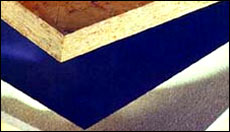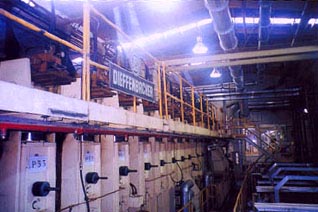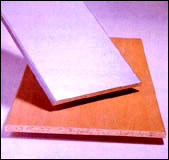World Wood-Based Panel Industries
|
||||||||||||||||||||||||||||||||||||||||||||||||||||||||||||||||||||||||||||||||||||||||||||||||||||||||||||||||||||
 Not all countries have moved ahead at the same rate in the wood-based panel industry. Some have experienced mill closures; some industries have seen excessive production capacity and despite rising demand, prices and profitability have weakened. Even so, the underlying growth in the panel industry cannot be denied. It may be argued that local and temporary difficulties are spurs to the industry to become more efficient in production, more innovative in product development, and more creative in marketing. Not all countries have moved ahead at the same rate in the wood-based panel industry. Some have experienced mill closures; some industries have seen excessive production capacity and despite rising demand, prices and profitability have weakened. Even so, the underlying growth in the panel industry cannot be denied. It may be argued that local and temporary difficulties are spurs to the industry to become more efficient in production, more innovative in product development, and more creative in marketing. |
||||||||||||||||||||||||||||||||||||||||||||||||||||||||||||||||||||||||||||||||||||||||||||||||||||||||||||||||||||
|
||||||||||||||||||||||||||||||||||||||||||||||||||||||||||||||||||||||||||||||||||||||||||||||||||||||||||||||||||||
| The underlying trend in all sectors of the panel industry is the seemingly inexorable increase in production capacity. By the end of 2002, world capacity of three panel types, namely particleboard, MDF, and OSB amounted to more than 142 million cubic metres.
These are total nameplate capacities for the year. Much of the new capacity during 2002, especially for MDF, was only effective for part of the year and therefore does not relate to actual production capability. The European Union possesses the greatest capacity, just edging out North America. The EU is ahead significantly for particleboard and MDF. Indeed, the EU is the leading region in the world for particleboard and MDF. North America, on the other hand, accounts for 86 percent of the world's OSB capacity. North America retains second place for particleboard even though recent capacity changes, as with MDF, have been relatively minor. Europe (EU and other Europe) has seen recent expansion in OSB capacity to reach a total of 3.1 million cubic metres. South America possesses capacity of 480,000 cubic metres. South America has also seen expansions in the new particleboard and MDF capacity to fairly significant levels in world terms. China has achieved the largest single country level of MDF capacity. Particleboard has stagnated by comparison. As shown in the table, OSB remains at the experimental stage. Australasia, in relation to its population and economic infrastructure, possesses relatively high levels of capacity. Consumption Trends The figure for particleboard is probably a little on the high side. Particleboard production in Europe and North America suffered a small setback in 2001 although it is believed both industries advanced again in 2002. The low capacity utilization is as much to do with the large number of old plants which exists and do not operate anywhere near their original nameplate capacity as it is too softening in demand. |
||||||||||||||||||||||||||||||||||||||||||||||||||||||||||||||||||||||||||||||||||||||||||||||||||||||||||||||||||||
|
||||||||||||||||||||||||||||||||||||||||||||||||||||||||||||||||||||||||||||||||||||||||||||||||||||||||||||||||||||
| OSB consumption amounted to 21.7 million cubic metres in 2001 and probably grew by around 8 percent during 2002. Despite exhibiting the highest capacity utilization among the panel products, it was insufficient to maintain consistent levels of economic pricing. The industry enjoyed some (very short-lived) peaks during 1999-2000 but since then, markedly lower levels of profitability have prevailed.
Embedded in this capacity and consumption data are numerous interesting features and trends, which are too many to elaborate upon in any detail here. Particleboard On the other hand, Southeast Asia will enjoy a mini-boom in new capacity. This might be an export-led phenomenon - with China as the destination. The boom in Vietnamese furniture industry led by mainly foreign investors, has triggered the announcement of nine small particleboard lines over the next few years. MDF Total Chinese furniture production is estimated at US$19.7 billion and exports are US$5.5 billion. The rise of China together with Southeast Asia (including Vietnam) as furniture and other processed-wood products exporters is beginning to impact the structure of these industries globally. The Asian industries exports throughout the world and imports into the United States could account for a 15 to 20 percent decrease in the US furniture production capacity. Little wonder that US MDF and particleboard producers are cautious as they see their home customer base disappear. The Japanese demand is also sluggish following their economic collapse after 1997. Their furniture industry is also moving offshore. One of the star performers for MDF consumption is South Korea. Consumption in 2002 is estimated at 2 million cubic metres and they are now the fourth largest consuming country in the world, after China, the US and Germany. South America is also a dynamic region for new capacity. It may take a little while for domestic demand to catch up. In the mean time, South America, together with Australasia and Southeast Asia, are highly dependent on export markets for the viability of their industry. As local capacity increases throughout the world, these industries may find themselves overexposed in due course. |
||||||||||||||||||||||||||||||||||||||||||||||||||||||||||||||||||||||||||||||||||||||||||||||||||||||||||||||||||||
|
||||||||||||||||||||||||||||||||||||||||||||||||||||||||||||||||||||||||||||||||||||||||||||||||||||||||||||||||||||
| OSB OSB consumption is remarkably concentrated both geographically and by end use. 92 percent is in construction. More than 60 percent of consumption is found in timber frame walls, roofs, and flooring. Some estimates of the relative importance of various applications are shown in the table. It is easy to see where plywood, especially softwood plywood in Europe and North America, has been squeezed. There are significant differences between the construction markets in these three regions - the US, Europe and Japan. The US builds 1.6 million houses and a further 250,000 mobile homes (and has remained at around these levels for several years). More than 95 percent of US homes are wood frame. Japan builds about 1.1 million houses of which 500,000 are wood frame (and less than 100,000 units approximate to North American styles). Europe builds about 1.8 million houses of which 100,000 are wood frame. The OSB industry must be hoping for a boom in wood frame housing construction. Korea builds about 600,000 dwellings but only 2,000 are wood frame. China's house-building programme has yet to be quantified with any accuracy. Estimates have ranged from 4 million to 22 million units annually. This author is still attempting to solve the puzzle but is prepared to believe four to 12 million units. Whatever the national number might be, most units are high-rise concrete. Low-rise dwellings are concrete or brick. Recent surveys show an aggregate wood frame housing stock of just 1,600 units. The more interesting prospects for wood frame construction and demand for structural panels/engineered wood products is likely to be in Eastern Europe and Russia. Wood houses afford numerous benefits where there are long, cold winters and short building seasons in the summer. |
||||||||||||||||||||||||||||||||||||||||||||||||||||||||||||||||||||||||||||||||||||||||||||||||||||||||||||||||||||
|
||||||||||||||||||||||||||||||||||||||||||||||||||||||||||||||||||||||||||||||||||||||||||||||||||||||||||||||||||||

 The final consumption statistics for 2002 are not available on a global basis at the time of writing. Nevertheless, for 2001 it is estimated that panel consumption amounted to 106 million cubic metres or just 75 percent of global capacity.
The final consumption statistics for 2002 are not available on a global basis at the time of writing. Nevertheless, for 2001 it is estimated that panel consumption amounted to 106 million cubic metres or just 75 percent of global capacity.